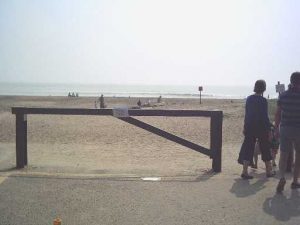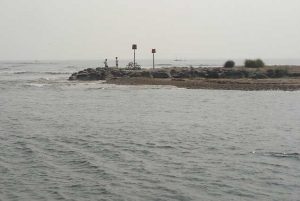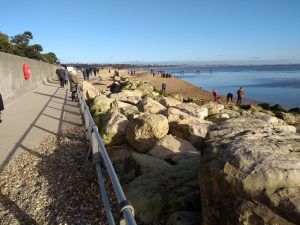Back around forty years ago Gundimore Beach didn’t really exist. The walk along the coast from Mudeford Quay to Avon Beach was along a concrete beach defence that was backed by a wall with the Sandhills Caravan Park behind it and the sea in front of it.

Sometimes due to tide/weather there was a small strip of wet sand visible. In rough weather or at high tide there was nothing.
In fact in rough weather you could be swept off the beach defence itself if you were silly enough to risk it.
But today there is a substantial sand and shingle beach that extends out in places by nearly 50 meters.
Gundimore: Dog Friendly Beach
Gundimore beach has been designated as a dog friendly beach so dog may be exercised on it all year round.
Water Sports.

This beach has been designated as a Water sports area. It has level and easy access from Mudeford Quay and its large car park. Swimmer and boarders should though be aware that (especially the western end) Gundimore beach is near Mudeford Quay and sits just beyond the notorious fast running outlet known locally as “The Run” where the output from Christchurch harbour and the rivers Stour and Avon combine. The flow can reach several knots on a falling tide. So be aware of the tidal conditions while enjoying your sport. Also be aware there is no lifeguard station on this beach.
Beach Huts
There was some controversy back in 2014 when the council built ten or so beach huts just in front of the sea defence wall that separates the beach from Sandhill Holiday Park. A number of nearby huts were destroyed by a storm a few weeks earlier. The position of the new huts appeared quite vulnerable to the elements. But they all sold. Almost immediately for around £25,000 each. I would suspect that now they are each worth probably four times that (or more). As for the elements, well, the huts are still there.
Parking
Mudeford Quay Car Park (BH23 4AB)
This is a large (450 spaces) rambling car park, mostly it is laid to tarmacadam and concrete. But there are odd areas of gravel. Along with areas of coarse and lawn there is a dinghy park at one end. Within it’s boundary includes a pub, restaurant, shops and a sailing club. It can get quite busy. There is also an RNLI station (Lifeboat – not lifeguard) and a few 18th century houses. A ferry runs over to Mudeford Sandspit. Mudeford Quay is an active professional fishing port so expect to see masses of Lobster pots and other Trawler paraphernalia stacked on the quay-side. Even so, it is arguably less busy than any of the other local car parks which tend to take the brunt of the main beach traffic for Avon Beach.
Avon Beach Car Park Mudeford (BH23 4AN)
This is a smaller and busier car park at the Eastern end of Gundimore beach. This car park is primarily aimed at clientele for Avon Beach. There are 90 spaces and it fills quickly. It does provide access to Gundimore Beach equally as good as that from Mudeford Quay. But in the summer season there is a lot of competition for parking space.
Other Parking
On-road parking is not good. All of the roads in the immediate vicinity of Mudeford Quay and Avon Beach being either totally no parking or severely time limited. Personally if you are going to Gundimore beach in the summer I’d go for Mudeford Quay car park..
Why call it Gundimore Beach?
The beach is named after a famous 18th century lodge house that sits to its rear. The Poet and MP Sir William Rose built it in the late 18th century. Here he entertained such visitors and fellow poets as Sir Walter Scott and Samuel Coleridge. Gundimore Lodge still exists. It is a listed building. But I believe it is now broken up into flats.
Gundimore Beach Formation
So you may ask why has this beach formed?
This coastline has been volatile for centuries. But back in the 1850’s the situation was made significantly worse by the Hengistbury Mining Company that stripped many thousands of tons of ironstone boulders off the shore at Hengistbury Head. Hengistbury Head rapidly eroded. Erosion also increased further west along the Bournemouth and Poole coastline.

Various hard beach defences were eventually built over the next 100 or so years to try and rectify the situation. These include the Bournemouth promenade, the Long Groyne as well as about 100 timber and rock groynes along the beaches. All of this had beneficial effects.
But the most immediately effective beach defence has been a Beach Recharge. This is where many thousands of tonnes of sand are dredged up from the sea bed and spread over the beaches. This has been a regular activity at different locations along the Bournemouth Bay beaches for the last 40 years.
But a beach recharge doesn’t actually stop the erosion. It is sacrificial. It simply gives the sea something else to move rather than the native content of Bournemouth beaches. So over the years the sand that was placed on Bournemouth Beach get washed down and around Hengistbury head and some of it ends up being deposited on the Christchurch beaches. Avon beach as well as FriarsCliffe and HighCliffe beaches are today much wider than they once were.
Of course, Gundimore beach is now really as proper full year round beach rather than then poor excuse for a beach it once was..
